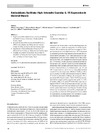Please use this identifier to cite or link to this item:
http://hdl.handle.net/10553/55019
| Title: | Antioxidants Facilitate High-intensity Exercise IL-15 Expression in Skeletal Muscle | Authors: | Pérez-López, Alberto Martin-Rincon, Marcos Santana, Alfredo Pérez-Suárez, Ismael Dorado, Cecilia Calbet, Jose A.L. Morales-Alamo, David |
UNESCO Clasification: | 241106 Fisiología del ejercicio | Keywords: | Myokines IL-15 Sprint exercise Glycolysis Oxidative stress |
Issue Date: | 2019 | Project: | Influencia Del Ejercicio Fisico, la Fio2 y El Estres Oxidativo en la Señalización Por Ampk en El Músculo Esquelético Humano. Desarrollo y Caracterización Molecular de Un Nuevo Modelo de Precondicionamiento Remoto |
Journal: | International Journal of Sports Medicine | Abstract: | Interleukin (IL)-15 stimulates mitochondrial biogenesis, fat oxidation, glucose uptake and myogenesis in skeletal muscle. However, the mechanisms by which exercise triggers IL-15 expression remain to be elucidated in humans. This study aimed at determining whether high-intensity exercise and exercise-induced RONS stimulate IL-15/IL-15Rα expression and its signaling pathway (STAT3) in human skeletal muscle. Nine volunteers performed a 30-s Wingate test in normoxia and hypoxia (PIO2=75 mmHg), 2 h after placebo or antioxidant administration (α-lipoic acid, vitamin C and E) in a randomized double-blind design. Blood samples and muscle biopsies (vastus lateralis) were obtained before, immediately after, and 30 and 120 min post-exercise. Sprint exercise upregulated skeletal muscle IL-15 protein expression (ANOVA, P=0.05), an effect accentuated by antioxidant administration in hypoxia (ANOVA, P=0.022). In antioxidant conditions, the increased IL-15 expression at 120 min post-exercise (33%; P=0.017) was associated with the oxygen deficit caused by the sprint (r=–0.54; P=0.020); while, IL-15 and Tyr705-STAT3 AUCs were also related (r=0.50; P=0.036). Antioxidant administration promotes IL-15 protein expression in human skeletal muscle after sprint exercise, particularly in severe acute hypoxia. Therefore, during intense muscle contraction, a reduced PO2 and glycolytic rate, and possibly, an attenuated RONS generation may facilitate IL-15 production, accompanied by STAT3 activation, in a process that does not require AMPK phosphorylation. | URI: | http://hdl.handle.net/10553/55019 | ISSN: | 0172-4622 | DOI: | 10.1055/a-0781-2527 | Source: | International Journal of Sports Medicine [ISSN 0172-4622], v. 40 (1), p. 16-22 |
| Appears in Collections: | Artículos |
SCOPUSTM
Citations
10
checked on May 12, 2024
WEB OF SCIENCETM
Citations
7
checked on Feb 25, 2024
Page view(s)
138
checked on Mar 9, 2024
Download(s)
878
checked on Mar 9, 2024
Google ScholarTM
Check
Altmetric
Share
Export metadata
Items in accedaCRIS are protected by copyright, with all rights reserved, unless otherwise indicated.
